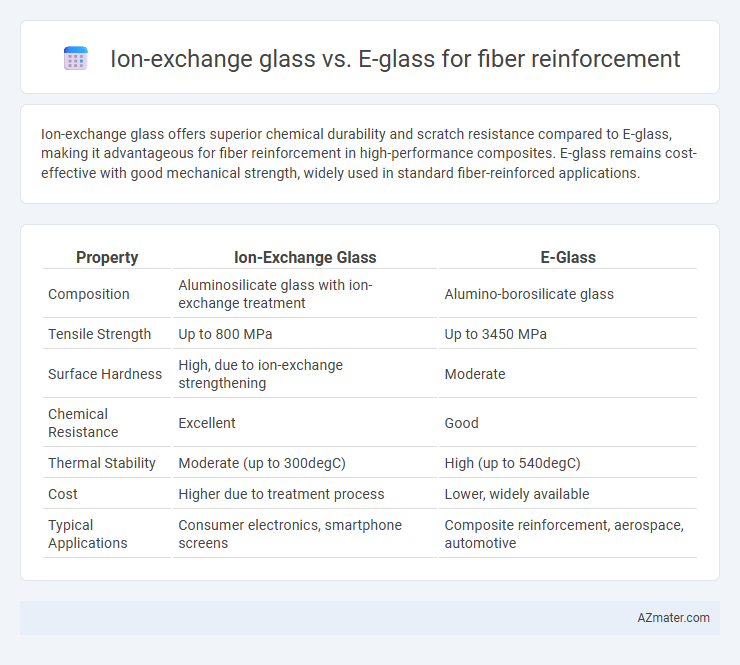Ion-exchange glass offers superior chemical durability and scratch resistance compared to E-glass, making it advantageous for fiber reinforcement in high-performance composites. E-glass remains cost-effective with good mechanical strength, widely used in standard fiber-reinforced applications.
Table of Comparison
| Property | Ion-Exchange Glass | E-Glass |
|---|---|---|
| Composition | Aluminosilicate glass with ion-exchange treatment | Alumino-borosilicate glass |
| Tensile Strength | Up to 800 MPa | Up to 3450 MPa |
| Surface Hardness | High, due to ion-exchange strengthening | Moderate |
| Chemical Resistance | Excellent | Good |
| Thermal Stability | Moderate (up to 300degC) | High (up to 540degC) |
| Cost | Higher due to treatment process | Lower, widely available |
| Typical Applications | Consumer electronics, smartphone screens | Composite reinforcement, aerospace, automotive |
Introduction to Fiber Reinforcement
Ion-exchange glass offers enhanced mechanical properties and chemical durability compared to traditional E-glass, making it a promising choice for fiber reinforcement applications. The ion-exchange process modifies the glass surface by replacing smaller ions with larger ones, resulting in increased strength and improved resistance to environmental degradation. These characteristics make ion-exchange glass fibers suitable for high-performance composites in aerospace, automotive, and construction industries.
Overview of Ion-Exchange Glass
Ion-exchange glass features enhanced strength and chemical durability achieved through a surface strengthening process where smaller sodium ions in the glass are replaced by larger potassium ions, creating compressive stress layers. This surface modification significantly improves resistance to surface flaws and mechanical wear compared to traditional E-glass fibers. Ion-exchange glass fibers are increasingly utilized in fiber reinforcement applications requiring higher performance in harsh environmental conditions and mechanical durability.
E-Glass: Composition and Properties
E-glass, primarily composed of silica (SiO2), alumina (Al2O3), calcium oxide (CaO), and boron oxide (B2O3), offers high tensile strength and excellent electrical insulation properties, making it ideal for fiber reinforcement applications. Its balanced chemical composition provides superior chemical resistance and thermal stability, setting it apart from ion-exchange glass, which is often enhanced for surface strength but lacks E-glass's structural robustness. The unique combination of mechanical strength and durability in E-glass fibers supports their widespread use in composites for automotive, aerospace, and construction industries.
Mechanical Performance: Ion-Exchange Glass vs. E-Glass
Ion-exchange glass exhibits superior mechanical performance compared to E-glass due to its enhanced surface compressive stress, resulting in higher tensile strength and improved fracture toughness. This process strengthens the glass fibers, making ion-exchange glass more resistant to crack propagation and mechanical fatigue under cyclic loading. E-glass, while cost-effective and widely used, generally demonstrates lower strength and durability in fiber-reinforced composites, limiting its applications where high mechanical performance is critical.
Chemical Resistance Comparison
Ion-exchange glass demonstrates superior chemical resistance compared to E-glass due to its surface layer enriched with larger alkali ions, which enhances durability against acidic and alkaline environments. E-glass fibers, primarily composed of alumino-borosilicate, offer moderate resistance but tend to degrade faster when exposed to aggressive chemicals, leading to compromised structural integrity. This makes ion-exchange glass a preferred choice for fiber reinforcement in harsh chemical settings requiring prolonged material stability.
Thermal Stability and Performance
Ion-exchange glass offers superior thermal stability compared to E-glass due to its enhanced surface compressive stress, resulting from the ion-exchange process that replaces smaller ions with larger ones in the glass matrix. This process improves the glass's resistance to thermal shock and high-temperature degradation, making it more suitable for fiber reinforcement in applications exposed to elevated temperatures. E-glass, while widely used for its cost-effectiveness and mechanical strength, exhibits lower thermal stability and performance under prolonged high-temperature conditions.
Durability and Lifespan in Applications
Ion-exchange glass offers superior durability and lifespan compared to E-glass for fiber reinforcement due to its enhanced surface compression and resistance to mechanical stress and environmental degradation. The ion-exchange process strengthens the glass fibers, resulting in higher resistance to cracking, moisture ingress, and chemical attack, which significantly extends the material's operational lifespan. In contrast, E-glass fibers exhibit lower durability under harsh conditions, leading to faster degradation and reduced service life in demanding applications.
Cost Efficiency and Manufacturing Considerations
Ion-exchange glass fibers offer enhanced chemical durability and mechanical strength but come with higher production costs compared to E-glass fibers, which are renowned for their cost efficiency and widespread availability. Manufacturing ion-exchange glass requires more complex processes and specialized equipment, increasing overall expenses and limiting large-scale production. In contrast, E-glass benefits from established manufacturing methods, enabling faster production cycles and lower material costs, making it the preferred choice for budget-sensitive fiber reinforcement applications.
Applications: Best Use Cases for Each Glass Type
Ion-exchange glass is preferred in fiber reinforcement applications requiring enhanced chemical resistance and surface durability, making it ideal for high-performance composites in aerospace and automotive industries. E-glass excels in cost-effective structural components such as wind turbine blades, marine vessels, and sporting goods due to its balanced strength and affordability. Selecting between ion-exchange glass and E-glass depends on performance requirements, environmental exposure, and budget constraints within composite manufacturing.
Future Trends in Fiber Reinforcement Technologies
Ion-exchange glass offers enhanced surface strength and chemical durability compared to traditional E-glass, making it a promising material for next-generation fiber reinforcement applications. Future trends indicate a shift toward hybrid composites that integrate ion-exchange glass fibers with advanced resin systems to improve mechanical performance and environmental resistance. Innovations in ion-exchange processes aim to optimize fiber-matrix bonding, enabling higher load-bearing composites for aerospace and automotive industries.

Infographic: Ion-exchange glass vs E-glass for Fiber reinforcement
 azmater.com
azmater.com